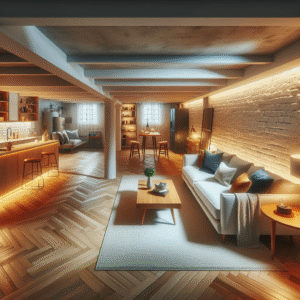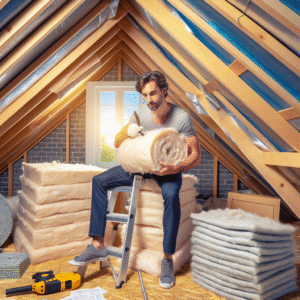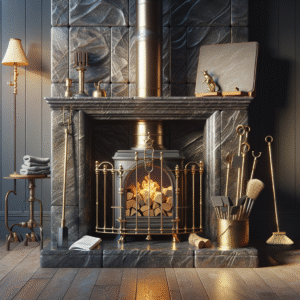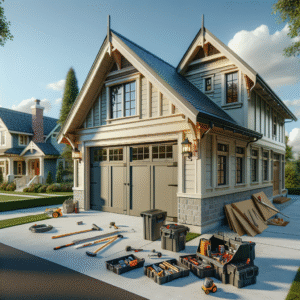Are you considering a green transformation for your home that not only enhances its aesthetic appeal but also contributes positively to the environment? A Green Roof might just be the innovative solution you’re looking for. This sustainable feature is gaining popularity among homeowners who are eager to embrace eco-friendly practices. In this blog, we’ll delve into what exactly a green roof is, explore its numerous benefits, and provide you with a simple guide on how you can integrate this green innovation into your own home.
What is a Green Roof? An Introduction to Sustainable Home Solutions
A green roof, often referred to as a living roof, is a system that grows vegetation on the rooftop of buildings. This isn’t just about placing potted plants on your roof; it involves creating a layered system that supports plant life, which can range from simple grasses and sedums to more elaborate gardens with bushes and small trees. Not only do these green roofs provide a unique visual element to your home, but they also offer a range of ecological and economic benefits.
5 Key Benefits of Installing a Green Roof on Your Home
- Improved Energy Efficiency: Green roofs provide natural insulation, reducing the need for heating in winter and cooling in summer.
- Extended Roof Lifespan: By protecting the underlying roof material from extreme temperature fluctuations and UV exposure, green roofs can double or even triple the lifespan of your roofing.
- Stormwater Management: They absorb and retain rainwater, easing the strain on urban drainage systems and reducing the risk of flooding.
- Enhanced Air Quality: The plants on green roofs can capture airborne pollutants and filter noxious gases, improving air quality around your home.
- Increased Biodiversity: Green roofs can create habitats for various bird species, insects, and other wildlife, increasing urban biodiversity.
How to Get Started: 3 Steps to Adding a Green Roof to Your Property
Adding a green roof to your home might seem like a daunting project, but with the right planning, it can be a smooth and rewarding process. Here’s how you can begin:
- Assessment and Planning: Consult with a structural engineer and a specialized green roofing contractor to ensure your roof can support the additional weight.
- Design: Work with a designer to choose the right type of green roof for your house based on climate, roof size, and personal preferences.
- Installation: Hire a professional with experience in installing green roofs to ensure proper installation and long-term success.
Embracing a green roof not only enhances the beauty and functionality of your home but also makes a positive impact on the environment. It’s a win-win for you and the planet!

If you’re ready to take your home improvement or construction project to the next level, we can help! Find trusted contractors on BuildNet, whether you’re looking for renovations, new builds, electrical work, plumbing, or anything in between. Our directory connects you with qualified professionals who can make your vision a reality.
What is a Green Roof? An Introduction to Sustainable Home Solutions
If you’re looking to add a touch of green to your home—quite literally—then green roofs might just be what you need! This innovative and sustainable home solution has been gaining traction globally, not just for its aesthetic appeal but also for its environmental and practical benefits. But what exactly is a green roof, and why should you consider it for your home? Let’s dive in and explore this green innovation together.
Defining the Green Roof
A green roof, also known as a living roof, is a roof of a building that is partially or completely covered with vegetation and a growing medium, planted over a waterproofing membrane. It may also include additional layers such as a root barrier and drainage and irrigation systems. From small, sedum-covered homes to expansive commercial buildings sporting lush gardens, green roofs come in various types and sizes.
They are primarily categorized into two types:
- Extensive Green Roofs: These are lightweight, low-maintenance, and typically feature a shallow layer of vegetation. Ideal for larger areas not frequently accessed.
- Intensive Green Roofs: Resembling traditional gardens with deeper soil depths, these support a wider variety of plants, require more maintenance, and are often accessible.
The Core Components of a Green Roof
To understand how green roofs work, it’s essential to know the layers that make up the structure. Starting from the top, here’s what a typical green roof includes:
- Vegetation: The type of plants can range from grasses, herbs, and flowers to shrubs and trees, depending on the depth of the substrate and the design of the roof.
- Growing Medium: Soil or a soil substitute, this layer supports plant life. The composition is tailored to sustain plant growth with minimal maintenance.
- Filter Fabric: This layer prevents the soil from washing away and allows water to drain through.
- Drainage Layer: Helps to manage water retention and drainage, preventing water from pooling on the roof.
- Root Barrier: Protects the roof structure by preventing roots from penetrating the waterproof membrane.
- Waterproof and Root Repellant Membrane: The critical layer that ensures the roof remains watertight.
- Structural Support: The roof itself must be capable of supporting the weight of all the above layers, especially when saturated.
Why Consider a Green Roof?
Now that you know what a green roof is and its basic structure, you might be wondering why you should consider installing one on your home. Here are a few compelling reasons:
- Environmental Benefits: Green roofs are fantastic for the environment. They reduce stormwater runoff, lower urban air temperatures (thus combating the urban heat island effect), and provide habitats for wildlife.
- Energy Efficiency: By providing natural insulation, green roofs can help reduce the amount of energy needed for heating or cooling, leading to potential savings on energy bills.
- Aesthetic Appeal: Let’s face it, a lush, green roof is visually stunning and can significantly enhance the architectural beauty of your home.
- Increased Property Value: With the growing trend towards sustainable living, homes with green roofs tend to have a higher market value.
- Longevity of Roof: By protecting the underlying roof covering from the elements, green roofs can extend the lifespan of your roof materials.
Is a Green Roof Right for You?
Before you decide to install a green roof, consider the following:
- Structural Requirements: Not all buildings can support the additional weight of a green roof without structural reinforcement. Consulting with a structural engineer is a crucial first step.
- Maintenance Needs: While extensive green roofs are relatively low maintenance, they still require some upkeep. Intensive roofs will need more regular gardening services.
- Budget: Installation of a green roof can be more costly than traditional roofing materials. However, the long-term benefits and potential energy savings can offset the initial expense.
- Local Climate: The types of plants suitable for your green roof will depend greatly on your local climate. It’s essential to choose vegetation that will thrive in your specific environmental conditions.
Adopting green roofs as part of your home design not only positions you as a pioneer of sustainable living in your community but also sets the stage for a healthier, more aesthetically pleasing environment. Explore this option with local experts and see how your home can contribute towards a greener future!
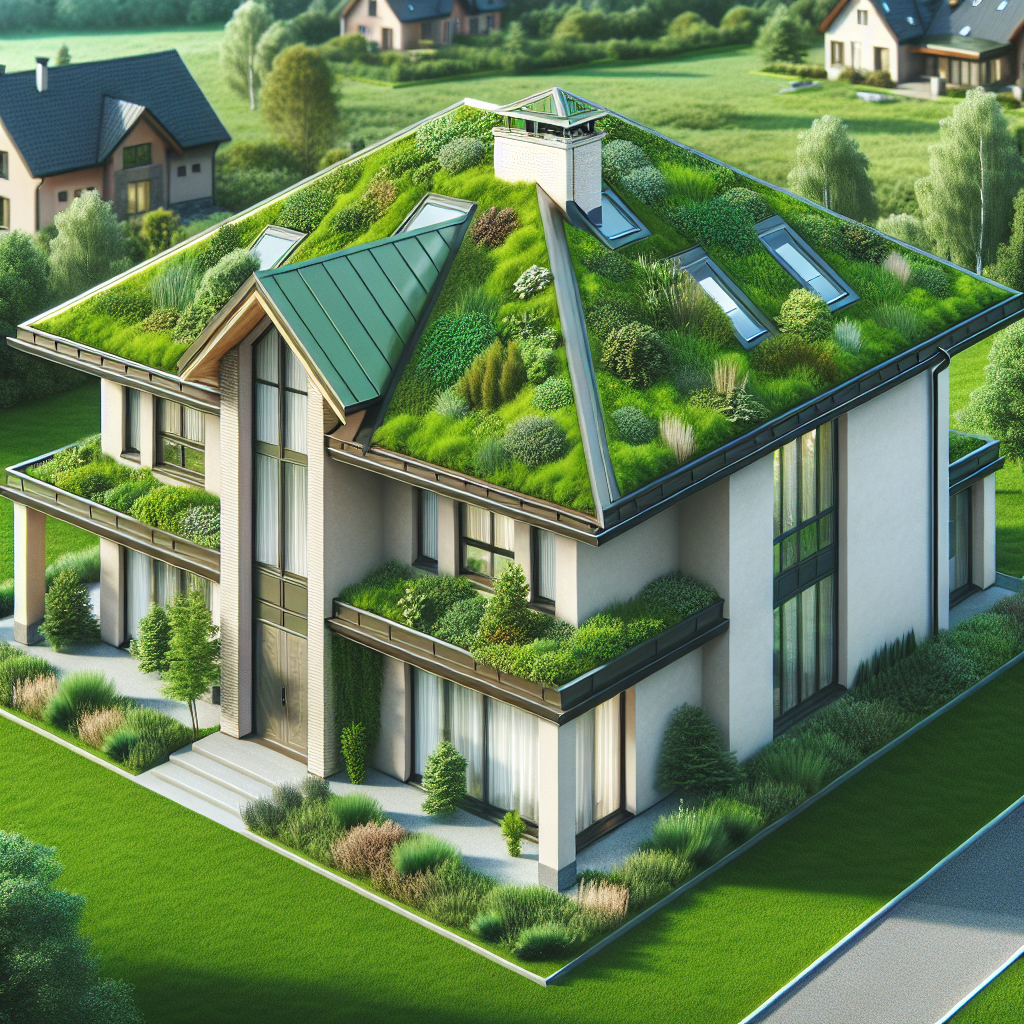
5 Key Benefits of Installing a Green Roof on Your Home
Thinking about turning your roof green? This eco-friendly home improvement is more than just pleasing to the eye. Below, we explore five compelling reasons why a green roof might just be the sustainable upgrade your home needs.
1. Enhanced Energy Efficiency
If you’re keen on slashing those pesky heating and cooling costs, a green roof could be your new best friend. Insulation is the magic word here. The layers of vegetation act as natural insulators, reducing the demand on your home’s heating and cooling systems. During summer, the plants reflect sunlight and provide shade, while in the winter, they minimize heat loss. Studies suggest that green roofs can reduce the need for air conditioning by up to 75%. This not only leads to a comfortable living environment but also significantly lowers your energy bills, making this a smart choice for energy conservation.
2. Extended Roof Longevity
Think of a green roof as a shield, guarding your house against the elements. The vegetation layer protects the underlying roofing materials from UV radiation and extreme temperature fluctuations, both of which can cause significant wear and tear over time. By installing a green roof, you could potentially double the lifespan of your roofing system. This means less frequent replacements and repairs, translating to more savings and less hassle for homeowners.
3. Stormwater Management
Flooding might not be the first thing you think of when considering roof upgrades, but green roofs are excellent for stormwater management. They absorb and retain rainwater, which helps to reduce runoff and lowers the risk of flooding. This not only protects your property but also alleviates the burden on local sewer systems during heavy downpours. Additionally, the water retained by the plants is eventually returned to the environment through transpiration and evaporation, contributing to a more balanced urban hydrology.
4. Improvement in Air Quality
Adding a touch of green to your roof does more than just beautify your home—it turns your roof into a small-scale air purification station. The plants on green roofs can trap dust, pollutants, and carbon dioxide, transforming them into oxygen. Imagine your home as a contributor to cleaner air in your neighborhood. Plus, this natural air filtering process can lead to a healthier living environment, making your green roof an integral part of your lifestyle.
5. Biodiversity and Habitat Creation
In urban areas, green spaces are often scarce. A green roof can provide a much-needed refuge for local wildlife, particularly pollinators such as bees and butterflies. By choosing a variety of plants adapted to your local climate, your roof can become a bustling micro-ecosystem. This not only helps to preserve local wildlife but also contributes to biodiversity. For those passionate about conservation, a green roof offers a unique opportunity to make a direct, positive impact right from their own homes.
Installing a green roof is more than just a home improvement project; it’s a contribution to a more sustainable and eco-friendly world. Whether you’re looking to cut down on energy costs, extend the lifespan of your roof, manage stormwater more effectively, improve local air quality, or support urban biodiversity, a green roof provides all these benefits and more. So why not consider it for your next home upgrade?
How to Get Started: 3 Steps to Adding a Green Roof to Your Property
So, you’re excited about the idea of transforming your roof into a lush, green oasis? That’s fantastic! Green roofs not only beautify your home but also offer a myriad of environmental benefits. Whether you’re a seasoned gardener or a newbie to the green scene, adding a green roof to your property can be a rewarding project. Follow these three steps to ensure your green roof project starts on the right foot and blossoms into a success.
Step 1: Assess Your Roof’s Suitability
Before you dive into the world of green roofs, it’s essential to determine if your existing roof structure can support this eco-friendly upgrade. Here’s how to get the lay of the land—or in this case, the lay of the roof:
- Consult a Structural Engineer: This is a non-negotiable first step. A professional will assess the load-bearing capacity of your roof and confirm if additional support is necessary to handle the weight of a green roof, which includes soil, plants, and retained water.
- Roof Type and Material: Flat or slightly sloped roofs are typically best for green roofs. The material of your roof should also be considered; some materials may need to be replaced or treated before installing a green roof.
- Building Codes and Permits: Check with your local building department about any restrictions or required permits. This can vary widely depending on where you live, and it’s better to have all your legal ducks in a row before starting.
Remember, safety first! Never compromise on the structural integrity of your building. Once you have the green light from a structural perspective, you’re ready for the next step.
Step 2: Choose the Right Type of Green Roof
Not all green roofs are created equal. There are generally two main types to consider, each with its own set of requirements and benefits:
- Extensive Green Roofs: These are lightweight, low maintenance, and ideal for larger areas where recreational access is not required. They are typically home to mosses, sedums, and other hardy, drought-resistant plants.
- Intensive Green Roofs: If you’re dreaming of a rooftop garden where you can actually hang out, you might consider an intensive green roof. These can support a wider variety of plants, including shrubs and small trees, and require more maintenance and structural support due to their heavier weight.
Consider your climate, roof accessibility, and how much maintenance you’re willing to commit to when choosing between these options. Your choice will affect the materials and construction methods needed, so pick wisely!
Step 3: Design and Install Your Green Roof
Now comes the fun part—designing and installing your green roof! Here’s a streamlined path to help you through this process:
Designing Your Green Roof:
- Layout: Plan the layout based on the type of green roof you’ve selected. Think about aspects like sun exposure, drainage, and how you’ll use the space.
- Plant Selection: Choose plants that will thrive in your specific climate and roof conditions. Native plants are often a good choice as they require less water and maintenance.
- Waterproofing and Root Barrier: This is crucial. Install a high-quality waterproof membrane to protect your property, topped with a root barrier to prevent roots from causing damage.
- Drainage System: Proper drainage is critical to prevent water pooling. Install a layer that will help drain excess water yet retain enough moisture for the plants.
- Soil and Growing Medium: Use a lightweight soil or specially formulated green roof substrate that provides nutrients, retains moisture, and allows for proper drainage.
Installation:
While it’s possible for the DIY-savvy homeowner to install a green roof, hiring professionals is often recommended. They can ensure that every layer of your green roof is installed correctly, from the waterproof membrane to the final plantings. Local contractors with experience in green roofs can be invaluable, offering insights specific to your area’s climate and environmental conditions.
Finding the right contractor is easier than ever with platforms like BuildNet, where you can connect with local professionals who specialize in green roof projects. They can provide tailored advice, help with the heavy lifting, and ensure your green roof is both beautiful and functional.
Embarking on the green roof journey can be as exciting as it is rewarding. By following these steps, you’re well on your way to creating a sustainable, vibrant living space on top of your own home. Just imagine the possibilities!

What is a Green Roof?
A green roof, or living roof, is a roof of a building that is partially or completely covered with vegetation and a growing medium, planted over a waterproofing membrane. It might also include additional layers such as a root barrier and drainage and irrigation systems. Green roofs are an excellent way to enhance the environmental performance of your building while providing an aesthetically pleasing solution.
What are the Environmental Benefits of Green Roofs?
Green roofs are known for their significant environmental benefits. They help reduce the urban heat island effect, lower energy costs by providing natural insulation, manage stormwater runoff, and improve air quality by filtering pollutants. Additionally, they provide habitats for wildlife, helping to increase biodiversity in urban areas.
Can Green Roofs Extend the Lifespan of My Roof?
Yes, one of the practical benefits of green roofs is their ability to extend the lifespan of roofing materials. By protecting the roof from ultraviolet radiation and extreme temperature fluctuations, green roofs can potentially double the lifespan of your roofing materials, saving money and reducing the need for raw materials over time.
Are There Any Economic Benefits to Having a Green Roof?
Absolutely! Beyond environmental impacts, green roofs can offer significant economic benefits. They can improve the energy efficiency of a building, leading to lower heating and cooling costs. Moreover, green roofs can increase the real estate value of a building by making properties more attractive to prospective buyers or renters who value sustainability.
What Types of Plants are Suitable for Green Roofs?
The choice of plants for green roofs depends on the climate and the specific conditions of the roof. Typically, sedums and other succulents, grasses, wildflowers, and herbs are chosen for their hardiness and low maintenance needs. It’s important to select species that can thrive in the local climate with minimal irrigation and care.
How Do I Maintain a Green Roof?
Maintenance needs for green roofs vary depending on the type of green roof and the vegetation used. Generally, maintenance tasks might include weeding, fertilizing, and pruning. Ensuring proper drainage and inspecting the waterproof membrane for leaks is also crucial. Regular maintenance helps sustain the roof’s functionality and beauty.
Is a Green Roof Suitable for Any Type of Building?
Green roofs can be installed on a wide range of buildings, from residential homes to large commercial or industrial buildings. However, the structural capacity of the building must be assessed by a professional to ensure it can support the additional weight of a green roof, especially when wet.
How Can I Start Planning for a Green Roof Installation?
Starting with a professional assessment of your roof is essential. This involves checking structural integrity, existing roofing materials, and drainage systems. Consulting with a specialized green roof contractor can provide insights into the feasibility of a project tailored to your specific needs.
What Are the Initial Costs and Long-Term Savings of Green Roofs?
The initial installation costs of green roofs are generally higher than those of traditional roofs due to the additional materials and specialized labor required. However, the long-term savings from reduced energy costs, roof maintenance, and repair expenses can offset these initial costs. Additionally, green roofs can enhance property value and potentially lead to tax incentives.
How Does a Green Roof Contribute to LEED Certification?
Installing a green roof can contribute significantly to achieving LEED (Leadership in Energy and Environmental Design) certification points. Green roofs improve thermal performance, manage stormwater, and can create a habitat for wildlife, all of which are criteria evaluated under LEED certification.
Conclusion
In the world of sustainable home solutions, a green roof is not just a statement of environmental consciousness but a multifunctional system that offers a plethora of benefits. Whether it’s enhancing biodiversity, improving the thermal efficiency of your home, or simply making your space more aesthetically pleasing, the advantages of installing a green roof are substantial.
Ready to take the first step towards a greener future? I encourage you to reach out to a trusted contractor through BuildNet for a free quote. Our directory is filled with experienced professionals who can guide you through every step of your green roof installation. Remember, investing in a green roof is not just good for the environment—it’s also beneficial for your wellbeing and your wallet in the long run!

